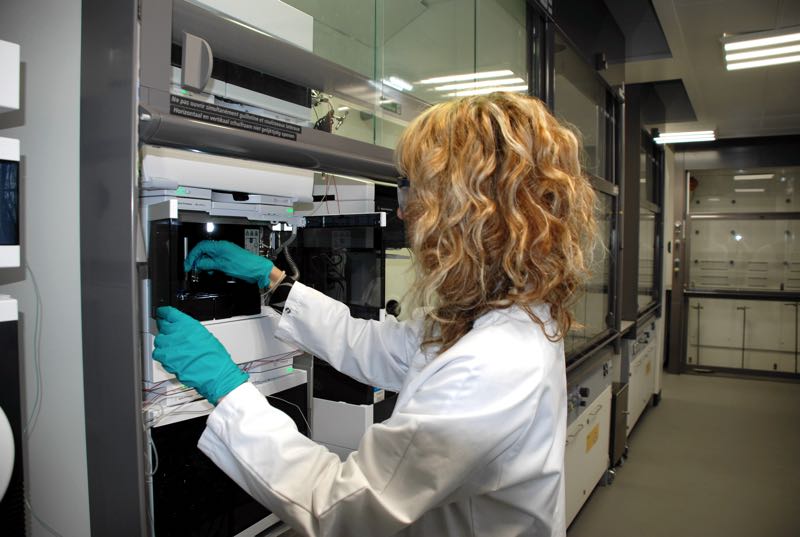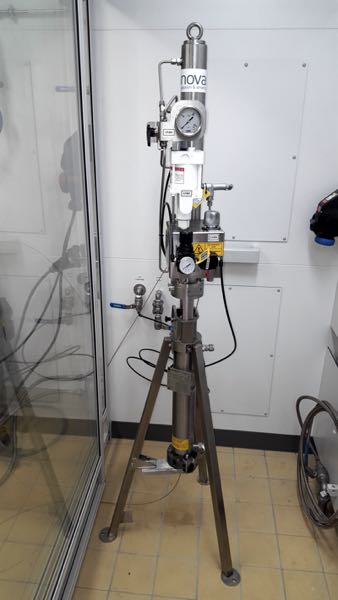The global demand for highly potent active pharmaceutical ingredients (HPAPIs) is deemed to have reached US$17 billion in 2018 and market research analysts forecast the sector will rocket to $26 billion by 2023; no wonder many contract development and manufacturing organisations (CDMOs) have been investing heavily in ramping up their facilities to accommodate the necessary equipment to boost production.
A facility upgrade, not to mention a construction project starting from scratch, requires careful consideration. HPAPIs are hazardous compounds, mostly used in oncology treatments, with an occupational exposure limit (OEL) of 10 µg/m3 or less.
Minakem, the pharmaceutical CDMO of the Belgium-based chemical specialist Minafin, made headlines in June last year as the company entered the final qualification run to open a new closed controlled environment at its manufacturing site in Louvain-La-Neuve, 30km southeast of Brussels. The project, a high containment production facility, began operation two months later.
“The Louvain-La-Neuve site has been handling HPAPIs for over four decades,” Amadeo Ferreira, R&D Manager at Minakem, points out. "Its activities in this area began with vinca alcaloïds (vinblastine, vincristine, vinorelbine and vindesine), a set of anti-mitotic and anti-microtubule alkaloid agents used for anti-cancer drugs, with an operational exposure limit (OEL) as low as 0.1µg/m3,” he says.
During this period, the company entered into several partnerships and engaged with the scientific community to further develop laboratory processes for the safe production of HPAPIs. "Minakem has continued producing commercial HPAPI with OEL of 0.1µg/m3 at this facility and is working on new process developments for future and promising drugs," he enthuses.
Design of the laboratory
In 2018, Minakem invested nearly €2 million in the Louvain-La-Neuve site to expand R&D capacity of the 150sqm plant. The move also aimed to address new challenges in ensuring that containment levels of HPAPIs are met without compromising its ability to respond to increasing demand from customers to accelerate delivery.
“Minakem designed a state-of-the-art laboratory, paying close attention to how best to remain flexible,” Ferreira says. “As an organic chemist, it is important for Minakem to support its customers in multi-step synthesis with all the complexities involved in processes, new technologies and analysis while offering a containment level below 0. 1µg/m3,” he adds.
Risk management was the key priority during the lab design phase. According to Ferreira, to assess containment in a lab environment, Minakem evaluated two approaches.

Minakem's manufacturing site in Louvain-La-Neuve, 30km southeast of Brussels
"A conservative approach would entail fitting lab suites with glove boxes where every chemical step would be conducted inside the air-tight chamber,” Ferreira says, adding that glove boxes are very well suited for high-risk environments.
Ferreira continues: “While it is paramount to avoid exposure, glove boxes are costly and offer less flexibility, and integrating other equipment in glove boxes is difficult. There are compatibility issues when using sealing joints with solvents and corrosion can occur when handling acids in stainless-steel glove boxes. Another drawback is that the gloves can impede operator dexterity."
An alternative approach, Ferreira points out, would require using a standard laboratory design equipped with fume hoods. This configuration eliminates the need for glove boxes, but it requires operators to use personal protective equipment (PPE). "Based on its long track record and in-depth experience in handling very highly potent drugs, Minakem concluded that, depending on the outcome of its own assessment of the risk of exposure, the optimal solution would be a combination of both approaches," Ferreira recalls. In this scenario, for example, the staff would use glove boxes when handling solutions or wet powders."
Minakem set a market benchmark, Ferreira says, and carried out a risk assessment (RA) on individual tasks to lay out the principles behind the design of the laboratory. The RA identified that dry powder handling was the main potential exposure constraint, with solutions and wet powder handling being less subjected to the risk of exposure, even if the potency was still present.
"Based on this initial assessment, two main areas were defined for risk consideration: focus on the handling of dry powder and developing a process without direct exposure to the dry compound," he explains.
Containment strategy
Minakem conducted a multiyear feasibility study to identify and describe the health hazards for each drug substance, and then calculate a health-based exposure limit. The investigation took into account an RA of cross-contamination including the batch size, the physical quality of compounds, the design of the room, equipment surface areas and cleaning process parameters, to name but a few.
As a result, rooms were equipped to provide environments of the highest standards to ensure equipment efficiency. The machinery was selected by its expected level of containment. Ferreira explains: "The dry powder area is equipped with glove boxes, pass boxes for chemicals, wastes and samples, and safety cabinets. Ovens are installed inside the glove boxes.”
According to this design, once the product is dry inside the glove box, it is then split into small quantities in vials with septum allowing the future introduction of solvents for processing needs without direct exposure. Ferreira continues: "In the chemical area, fume hoods compliant with EN 14475 and confinement test using SF6 at 0.02 ppm level have been chosen to be used for process development."
The laboratory is now set up with several different areas: the entrance to an overpressured (+10Pa) room, a gowning/de-gowning area (-10Pa), a process laboratory (-20 Pa), and a powder area (-30Pa). Each room is interlocked and treated with HEPA filters, both the inlet and exhaust.
“The HVAC system was qualified by a certified third party. Substantial data, such as the air velocity in the room, the pressure in the HEPA system, the cascade pressure between rooms, and other parameters are monitored in real-time and alarms are present to signal any dysfunction,” he says.
GMP and keeping staff safe
According to Ferreira, Minakem's reputation in HPAPI manufacturing is partly due to ensuring the required safety for its operators, the environment and patients. “Minakem has established a long track record in producing GMP compounds. Today, the lab produces HPAPI batches from a few milligrams to 100g that adhere to ICH.Q7 section 19 for use in clinical trials,” he notes.The International Council for Harmonisation of Technical Requirements for Pharmaceuticals for Human Use (ICH) is a project that brings together the regulatory framework of Europe, Japan and the US with experts from the pharmaceutical industry in those regions to discuss scientific and technical aspects of pharmaceutical product registration.

“Minakem is seeing a growing number of clients looking for HPAPI services, where labs conduct more thorough audits and risk assessments when evaluating potential outsourcing partners,” he points out. To ensure smooth operations, Minakem systematically carries out rigorous risk assessments on the safe handling of hazardous drugs for each new project. Internal audits will then be conducted for equipment performance characterisation in Minakem’s actual lab against the supplier’s acceptable level of containment.
Risk analysis for handling HPAPIs
Ferreira says the company works on the assumption that a piece of equipment tested on the supplier’s premises may not necessarily perform to the same standards in different working environments, accounting for factors such as the design of the room, surrounding equipment or the security measures in place.
Three preparative, high-performance liquid chromatography (HPLC) units are operative
“The audit also includes tests using a surrogate molecule with a defined level of toxicity to generate data on the efficacy of Minakem’s monitoring equipment in avoiding exposure and contamination," Ferreira explains. The assessment, he points out, follows the ISPE Good Practice Guide “Assessing the particulate containment performance of pharmaceutical equipment”.
Minakem sees its operational procedures as pillars in the effectiveness of containment. This recent investment, Ferreira explains, provided an opportunity to demonstrate the efficacy of internal standard operating procedures (SOPs) that have been developed through many years of experience in highly potent drug development and manufacturing.
For Ferreira, continuous training is essential to ensure sustainable growth. “With the laboratory available, the HVAC system qualified and SOPs, the site will continue to improve its operations using air and work in progress controls, or WIP, to develop a sustainable safety culture,” he says.. Every new project, Ferreira says, will go through a failure mode and effects analysis (FMEA) to identify Minakem's strengths and weaknesses while, if needed, applying additional precautions. “This new facility offers a sustainable platform for new drug development in a safe environment,” he enthuses.
Aside from this new laboratory, Minakem also has GMP production at the Louvain-La-Neuve site with capacity from 100g to 100kg/batch for compounds with OELs as low as 0.1µg/m3. The company has recently invested in three preparative, high-performance liquid chromatography (HPLC) with columns from 50 to 300mm. “These capacities, together with a large toolbox of chemistries, will allow Minakem to further support clients in complex multistep processes under high containment, from early stages of clinical development to commercial launch and full lifecycle,” Ferreira says.
As the global offering in CDMO services increases, with many companies investing in highly potent capacity, Minakem’s recent investments targets further diversification in the industry, particularly in the oncology space.
Ferreira concludes: “Pharmaceutical companies are developing increasingly more complex and potent API to more efficiently target tumour cells, such as antibody drugs conjugates (ADC). With this new facility and equipment, Minakem will be able to provide the drug toxin and linker for ADC, further reinforcing its position in the market."
N.B. This article is featured in the January 2019 issue of Cleanroom Technology. The digital edition is available now.




